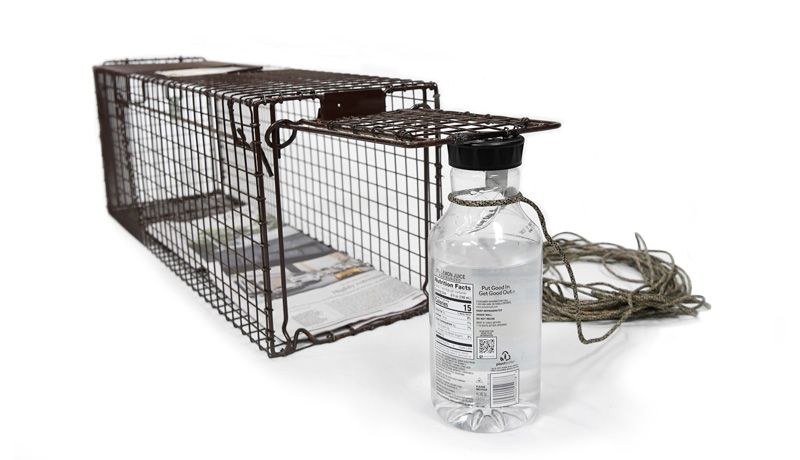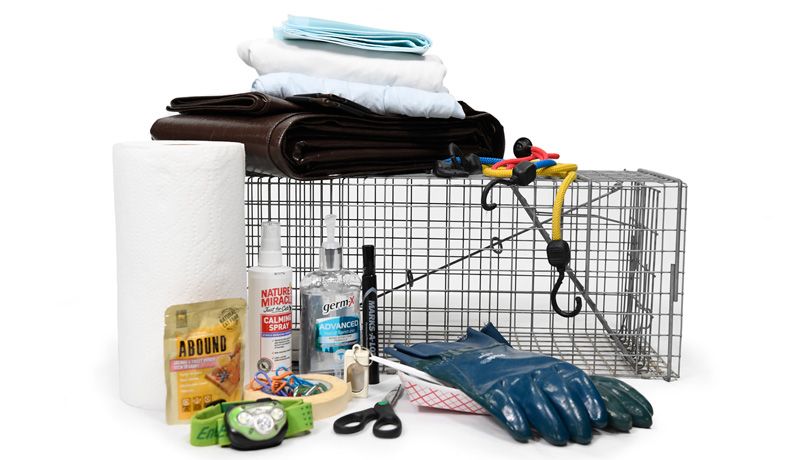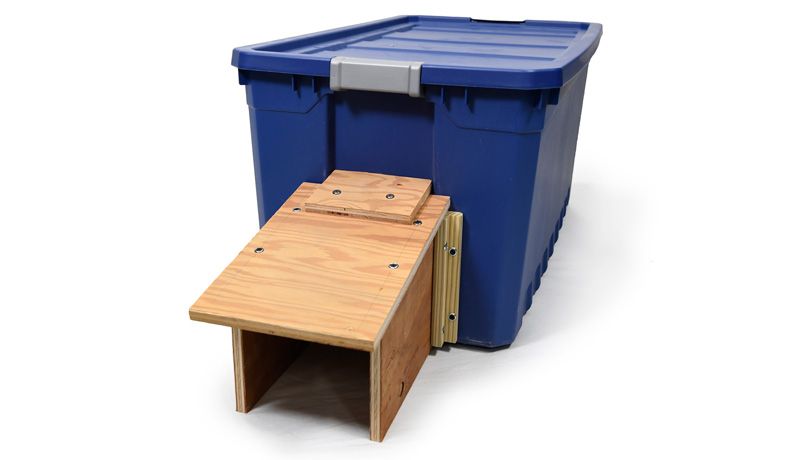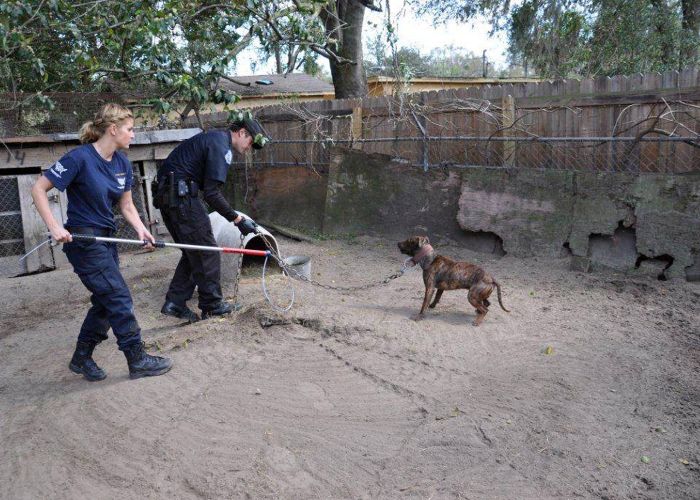Game changers
Tips for moving past stalemate in your cat-trapping efforts

Am I smarter than the average cat?
Years of doing trap-neuter-return have made me wonder. I’d never even heard the term “feral cat” when, as a volunteer for a grassroots animal advocacy group in the mid-’90s, I agreed to help a woman who was feeding cats outside her mobile home. After arranging low-cost spay/neuter surgeries with a charitable- minded veterinarian, I confidently showed up at the woman’s home with seven carriers for the seven cats.
Somehow, the local news station had caught wind of this effort, and for the next few hours, while the cameras were rolling and curious neighbors looked on, the caretaker and I tried unsuccessfully to lure a bunch of skittish cats into carriers.
Humiliated and empty-handed, I went home and ordered my first humane box traps. Things went much better on my next outing, and during that first year of a fledgling TNR program, a friend and I trapped 168 cats for sterilization. But I made a lot of rookie mistakes.
Like the time I bought the smelliest fried chicken I could find and set traps for two feral mommas who had evaded me for months. About 20 minutes later, I returned from checking on a colony a few streets away to find empty traps with no chicken. The cats had simply reached over the trip plates, snatched the meat and absconded with their bounty. (Twist ties attaching the chicken to the bottom of the traps would have prevented that outcome, a more experienced trapper later told me.)
My early TNR work coincided with the advent of the World Wide Web. The first time I used the internet, I typed “feral cat” into Dogpile, a popular search engine in the days before Google. It yielded exactly three hits. I got some good guidance from Alley Cat Allies and the Feral Cat Coalition of San Diego, but there were no websites where cat trappers could share tips and troubleshoot specific challenges.
Fortunately, community cat advocacy has grown tremendously over the years, and today I can tap a wealth of know-how from people around the globe. On countless listservs and social media groups, advocates give and receive advice on everything from trapping to transport to colony caretaking. Even after 20-plus years, I’m always learning something new.
Some things haven’t changed: TNR is still time-consuming work, most every colony has at least one feline genius determined to evade capture, and there are always more cats than there are people willing and able to do the work of trapping them. That’s why it’s essential that we maximize our impact by sharing our knowledge and experience.
To that end, we asked our readers and staff experts for their best trapping strategies and also pulled tips from Facebook group discussions and cat advocacy websites. (Some tips have been edited for clarity.) Maybe none of us can match the street smarts of a community cat—but we can learn to trap smarter, not harder.
It's essential that we maximize our impact by sharing our knowledge and experience.
The right lure
It’s easy to fall into the rut of using the same baits that have worked for other cats, but sometimes you need to switch it up. And as several readers pointed out, sometimes the best temptation isn’t food.
If you notice a cat isn’t interested in going in the trap, try using tuna, sardines or mackerel in oil and use the oil to drizzle a trail leading up to the trap and then put the actual fish in the back. It works great to entice most cats, and the smell carries further so it can entice them even if they aren’t daily visitors. —Vanessa Beyers, Feral Cat Coalition of Oregon
Trap momma using the kittens as “bait” in a safe closed carrier, placed behind the trap, and make a tunnel with a blanket over both. —Marion Wagner
If using the kittens to lure mom is not practical, I have actually “YouTubed” kitten cries on my phone, set a trap, taped the phone on the trap, pressed play and covered the trap. Sounds crazy, but it has worked! —Kelly Maguire, Maui Humane Society
Use cut up pizza boxes to line your trap and draw cats in with the leftover grease. —Laura Gretch
To lure in tom cats, use urine from in-heat female cats (collect swabs when they are in for TNR). —Dave Pauli, the Humane Society of the United States
Use a laser pointer to trap cats who aren’t interested in food. You can also try using dry food as bait since some cats just aren’t into wet food. —Karen Little, Alley Cat Advocates
I had good luck at a recent site lining the trap with an old carpet remnant that is sprayed with catnip spray and sprinkled with powdered valerian root. —Deb Skilton Webster

Disguised intent
While some cats can’t run into a trap fast enough, others will quickly figure out that those “metal boxes” are bad news. Several people recommended using traps that look different from your regular box traps—such as a dog trap, a “fat cat” trap or a drop trap—while others gave tips for disguising traps and helping cats lose their fear of them.
To get cats accustomed to the trap, put food in the trap on days that you’re not intending to catch them, and wire/tie the trap open so the cats can enter the trap, eat the food and get back out again. On the day you plan to take cats to the clinic/vet for spay/ neuter, make the trap operational, and the cats should enter the trap and get caught! —Phyllis Becker
Cats have an extraordinary sense of smell. Traps often smell like humans or cleaning products. Try wiping the trap with fresh catnip or sardine oil. Always leave trap covers outdoors to lose the human scent. —Feral Cat Focus of Western New York
I built a fake drop trap that can be left at a colony to get the cats used to eating under it and making trapping much easier. This was easy to make, and I don’t worry as much about it being stolen or destroyed when I leave it out. When you’re ready to trap, just switch it out with a real drop trap. —Krista Rakovan, the Humane Society of the United States
If you seem to be having trouble trapping a cat who won’t go near a trap, try disguising it by placing the trap in a paper sack or even inside a cardboard box. Cats love boxes and paper sacks. It works! —Kokomo Community Cats TNR Program
Brown paper lawn bags fit perfectly over traps. Just make a small slit for the trap handle. Also place newspaper under the trap in the bag to prolong use. —Debbie Calvani Salinardi
Have a plexiglass panel made [to replace the back door of] a trap that opens on both ends. —Leslie Raines
Editor’s note: If you can’t make your own, some trap manufacturers sell a clear acrylic panel for traps with a removable back door. Be sure to monitor the trap closely so you can quickly cover a trapped cat; otherwise, the cat could injure herself barging against the transparent panel.
I like to place two traps side by side, with the front doors facing opposite directions. A cat exploring the bait at the back end of one trap can then just follow the trail of food into the front door of the adjacent trap. —Danielle Bays, the Humane Society of the United States
Have the feeder do their normal feeding routine when you are trapping to encourage the cats. This could be the sound of their car engine, cracking open a can of food, whistling—whatever clues the cats in to feeding time. —Kelly Maguire

Time-saving tips
Through planning and some inexpensive equipment, you can minimize the hours you spend waiting for a cat to be trapped.
Before you start trapping, make it clear to the caretakers that they need a feeding schedule so you’re not wasting time. To modify the cats’ behavior, you have to modify the caretakers’ behavior. So instead of having food available 24/7, the cats will learn that food is out from 7-8 a.m. and 7-8 p.m. —Karen Little
Set a motion-sensor device next to the trap so you are alerted that something is moving in there. They are only $12 ... for a sensor and alarm! Then you don’t have to keep running outside to check the trap. —D. Lucy Potter
Use a video baby monitor for a drop trap. You can be out of sight and still trip the trap. —Sharon Nylac
We mounted a wildlife camera next to the drop trap, and it’s enabling us to know how many cats are there and what times of day they come to eat. A wireless cam will email photos to you, so you don’t have to remove a memory card and transfer photos to your computer. The one we’re using also doesn’t emit a flash like my basic trail cam does, so it draws less attention to the feeding area. It does need batteries replaced periodically. The camera also assists in the actual trapping: There was nowhere for me to be where the cats wouldn’t see me, so I had to go around the corner. But then I couldn’t see the drop trap. So we just waited for photos to pop up on email when a cat had gone onto the trap to eat. —Kim Deserio, Metro Ferals
Trail cams are a great investment to track the habits of those hard-to-catch kitties! When we were tracking our first colony, I just used to sit for hours assessing the cats and now am just too busy so am thankful for this option. —Lisa Wolkind

Trapping on a budget
With the growing popularity of TNR in recent decades, trap manufacturers have developed a slew of new products to meet the field’s needs. But there are also many inexpensive household products that can make your work easier and more effective.
For cats who reach over the trip plate to eat the bait without springing the trap, you can extend the trip plate by using a piece of cardboard taped to the trip plate. They can’t step over that. —Kokomo Community Cats TNR Program
Editor’s note: You can also purchase traps designed for TNR that have a longer trip plate.
Paper french fry trays, which you can buy online in bulk, are great for placing bait in the back of traps and for providing food and water to cats being held in traps. It saves a lot of cleaning. —Krista Rakovan
To make metal trap handles easier on your fingers and palms, take an ordinary garden hose and cut it into handle-sized segments. Slice each piece open length-wise, slip over the trap handles and secure with duct tape. Also, fitted crib sheets make great trap covers, and you can buy them used at thrift stores. —Susan Richmond, Neighborhood Cats
Sometimes the problem isn’t that the cat is wily, but that he’s the only one you want out of a crowd of others who keep going in the trap ahead of him. The solution is to go to manual control. Prop the front door of the trap open on top of a full water or soda bottle. Tie a long string around the neck of the bottle then stand some distance away. When your cat of choice finally goes in, yank the string, pulling the bottle away and shutting the door. Be sure to first practice the method at least once so you get the right feel for it, and wait until the cat is far enough in (up to or past the trip plate) before you pull the string. —Carol’s Ferals
When trapping in the dark, a headlamp can help you see what you are doing. Use some glow-in-the-dark spray paint on trap doors to make it easier to see if the trap has been tripped. And although I haven’t tried it yet, Tomahawk has a new “trap flag and light combo” product that lets you know when your trap has been sprung. —Danielle Bays
Along with cat food, water, traps and trap covers, you should put together a trapping kit with basic supplies like carabiner clips (for securing trap doors), masking tape and permanent markers (for noting which colony a cat came from), hand sanitizer and wipes, paper towels and trash bags, flashlights/headlamps, plastic spoons and can covers, binoculars (for spotting ear tips), newspaper for lining traps, tarps and pee pads for protecting your car, and clothes pins for securing the newspaper to the trap on windy days. —Danielle Bays

Ongoing care challenges
Even the most experienced caretakers may need advice from time to time on how to make colony care easier or resolve problems that threaten the cats’ safety. For advice on caretaking during times of extreme weather, see Resources below. Here are some other less-well-known caretaking hacks.
My favorite trick is the clicker. I can round up all my colonies simply by clicking. —Hope Mercedes Sapaula
Editor’s note: If you have to relocate cats to an adjacent property, clicker-training is also a good way to draw them to the new feeding location. Choose the loudest clicker you can find.
Set an automatic pet feeder up in a raccoon-proof setup so you don’t feel guilty when you can’t feed the colony every day. —Vanessa Dai
Currently giving the antibiotic Clavamox (provided by my veterinarian) to one of my colony cats for a suspected UTI. We have found that it is more palatable for her if we mix the Clavamox powder with tuna water (instead of tap water) to make the solution. We then add the medication to Purely Fancy Feast (tuna flavor), so the food/medicine is drenched in broth. She gobbles it up. —Dan Spehar
Especially when feeding on somebody else’s property (with permission), pick up trash! ... Building good relations and leaving a positive, professional impression reflects upon the cats. —Steffi Bruninghaus
If you need to hold a feral cat longer than a day or two and don’t have a large cage, place two traps with the back doors end to end. Using a trap divider to keep the cat in one trap, remove the back doors (or lift them up) and use several bungee cords to bind the traps together. This way, the cat will have double the recovery space. —Connie Markwood, Metro Ferals
If you have a cat who appears to be in questionable health during recovery, using a litter box with lab litter [nonabsorbent plastic litter designed for urine collection] and test strips to check the cat’s urine can be a practical way to rule in certain conditions. While it is obviously not nearly as useful as a full blood count, it is better than nothing and practical for feral cats. —Steffi Bruninghaus
We had a horrible time with black vultures last year. There would be up to 60 of them waiting at our colonies, and they would eat all of the cat food. We tried a fake owl, a vulture effigy, bird scare tape, squirting them with water, but nothing worked, and the cats were going hungry. What did work was building an anti-vulture feeder with entrances only the cats could fit through. —Krista Rakovan







